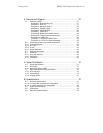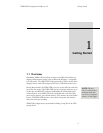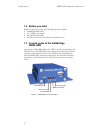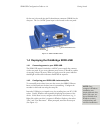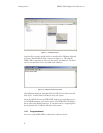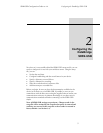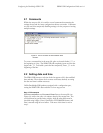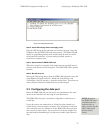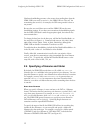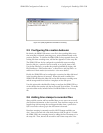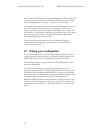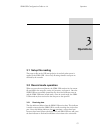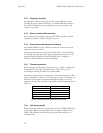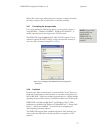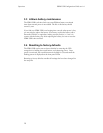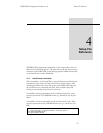Configuring the DataBridge SDR2-USB SDR2-USB Configuration Guide rev 1.0
12
Hardware handshaking prevents a data source from sending data when the
SDR2-USB is not ready to receive it – the SDR2-USB can “shut off” the
transmitting data source if, for example, the USB storage media is slow or
not present.
Be sure that your serial data source and the SDR2-USB use the same
handshaking settings. If your data source monitors the handshaking signals
but the SDR2-USB doesn't send the appropriate signal, the software may
never transmit data.
To change the baud rate for the data port, add the line DataPortBaud= to
the setup file as in Figure 1.4. Common baud rates are 300, 1200, 2400,
4800, 9600, 19200, 38400, 57600, 115200, 230400 bps, although the
SDR2-USB can handle “nonstandard” baud rates as well.
To enable hardware handshaking, include the line DataPortHandshake= in
in the file, with a value of 1 for enabled or 0 for disabled.
Finally, while 8N1 communication is used by the vast majority of data
sources, some devices communicate using nonstandard data word formats
such as 7E1. To specify this, add the line DataPortWordFormat= to the
setup file, with a value of 8N1, 7E1, etc.
2.4 Specifying a filename and folder
By default, the SDR2-USB records data to a file called SDR-0000.DAT
located in the
DATA subfolder in the storage device's root directory. You can
keep this filename or specify a new filename that reflects the data it contains.
For example, you may wish to use
PRESSURE.TXT for pressure data or a
name like
TEMP1109.TXT for temperature data from November 2009.
Likewise, your choice of folder names may reflect something about the data
it contains.
Notes about filenames
When you specify a filename, it must conform to the FAT 8+3 filename
format. This means that files contain up to 8 characters, a period ("dot"), and
up to three more characters. For example, BRIDGE.DAT, ABCDEFGH.123,
and
1 are all valid filenames, while DATA.FILE, and JOHNSMITH.TXT are
not. The SDR2-USB ignores characters you type that are not allowed in
FAT16 filenames, such as: \/*|[]. Specifying illegal characters can
sometimes result in unpredictable filenames.
To specify the name of the file the SDR2-USB will use for recording data,
include the line Filename= in your setup file and specify a folder and
filename after the equals sign. For example, to record to a folder named
“GPSDATA” and use a filename of “GPS-0000.TXT”, include the line
Filename=GPSDATA\GPS-0000.TXT (see Figure 2.3).



